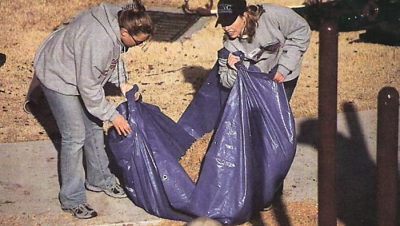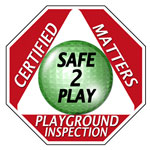It’s Time to Rethink Falls and Resilient Surfacing!
Two children fell from climbers today, somewhere in America, and you probably never heard about it. Tanya landed on a recently installed high-tech impact-attenuating surfacing (the proper term for a resilient safety surface), while Tim landed on hard-packed earth. One child went to the hospital with a fractured wrist, the other got up and kept playing, no worse for wear.
Which one of the two suffered the broken bone and which one never missed a beat? Surprise! Tanya, the child who landed on the impact-attenuating surface, made the trip to the hospital, while Tim, the child who landed on bare earth, had no injury at all. Did the high-tech surface fail to do its job? Did the playground owner waste money putting down that costly surfacing material? Wasn’t the child who landed on the packed earth just as safe as the one who broke his arm? No, no, and absolutely no!
Actually, that high-tech surface did its job well, preventing head trauma and other serious damage to the child, in spite of the height from which she fell. And the child who fell onto hard-packed earth got lucky, falling from a lower height and landing correctly to avoid injury. The outcomes of this fictitious but highly likely scenario illustrate how hard it is to predict which falls will result in serious injury, and they remind us that injuries can happen even when impact-attenuating surfaces are in place.
So where do we go from here in the battle to reduce injuries on playgrounds? What still needs to be done, and what new surfaces are being developed to reduce injuries from falls? Answering these questions requires that we reconsider what we know about children, falls, and surfacing.
Understanding Children, How They Fall, and Why.
When choosing surfacing for playgrounds, or when designing play environments, it is important to understand what causes falls among children of various ages and how those children fall. For example, using our illustration above, Tanya is a 12-year-old while Tim is three. Their play patterns are different, and so are their physical abilities when it comes to falls. Tanya likely fell while playing chase with her friends. Since 12- year-olds push the envelope of their developing physical skills and are motivated by a need to be part of a group of peers, she would have been concentrating on the outcome of the game, not on the safest way to come down a spiral slide. She, as well as all older children, needs an impact-attenuating surface (safety surface) that goes beyond the minimum requirement for resilience.
Consider the recent fall of a real 12-year-old in Texas. She, too, was playing chase with siblings when she slipped and fell from a structure with a 6’ high deck. Initial reports suggest she had climbed the supports for an attached metal climber to a height 12’ above ground before falling.*
* Some evidence suggests this injury was caused when the girl struck the metal bars of the climber as she fell. This possibility points to another area where playground designers must rethink old assumptions. Injuries from falls onto metal bars projecting away from elevated decks pose a growing hazard.
While the technical requirement of the Consumer Product Safety Commission (CPSC) Handbook for Public Playground Safety says the critical height of this equipment is 6’ (the height of the accessible surface or deck), the actual height from which she might have fallen was 12’, and knowing how 12-year-olds play, it is only reasonable to choose safety surfacing with a critical height of at least 12’. Look at your climbers and choose to surface adequate for the highest elements likely to be reached by users.
Likewise, three-year-olds have their own play patterns and needs. A three-year-old is more cautious physically, but no less curious than older children. His risks are more related to immature balance skills, and to the fact that his head is larger in proportion to the rest of his body as compared to older children. He is less sure of himself and less able to judge the risk of a particular behavior, simply because he has less experience, compared to older children. When he falls, he is more likely to have head trauma than older children, because his upper body is less developed and thus his hands and arms can’t cushion his impact.
So how do we apply this information when choosing safety surfacing?
We Know Less Than We Need to Know!
Reducing injuries from falls requires more research to answer the following questions:
- How do we design structures that create “free-fall” zones so that children only hit the safety surfacing and not some part of the structure on the way down? (This is an area of increasing risk, due to the prevalence of multi-deck structures with metal rung climbers extending away from elevated decks.)
- Do poured-in-place rubber or tiles lose resilience over time?
- Do loose fill surfaces (like sand or engineered wood fiber) perform better for certain types of falls, like hands-first or feet-first falls (since deeper surfaces move farther to accommodate extended limbs)?
- Do falls differ in their risk level if they have horizontal components in addition to vertical components (as when a child falls while moving forward)?
- Does the current testing protocol of dropping a head form straight down really approximate the way falls occur?
What Are the Trends in Impact-Attenuating Surfaces?
Since the late 70s, we have seen the rise and fall in popularity of several surfaces, including sand, pea gravel, engineered wood fiber, tiles, poured-in-place rubber, and chipped or shredded (loose) rubber. Each of these popular options can be the right one for a given situation, depending on the quality of the installation, budget, accessibility, age of the children, maintenance capability, and aesthetic tastes of the consumer. Even so, each has crested in popularity, and the consumer is looking for new options that are reliable, easy to maintain or repair, natural looking, and of course, compliant with current safety standards.
One such product being used more and more often is an artificial grass similar to turf used for athletic fields for a number of years. This particular product combines a rubber mat laid under a polyethylene grass-like fiber carpet. The grass blades are infilled with tiny rubber granules to create a hybrid unitary mat/loose fill product. This artificial turf looks like real grass, has a friendlier feel than other man-made products, and is receiving very positive reviews from customers.
Perhaps there are other hybrid products in development, combining the best characteristics of loose fill products like engineered wood fiber with those of rubber mats. Testing continues into variations of current options, like engineered wood fiber topped with a polyurethane binder. In theory, this combination would stabilize the movement of the wood fibers while minimizing costs.
Much more needs to be known about playground surfacing, including more detailed information about how particular surfacing types affect injuries, and how new products perform over time. So continues the research on surfacing.










Add new comment